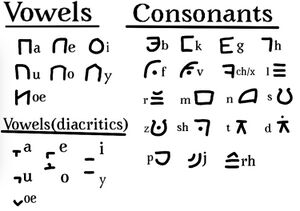Arnic: Difference between revisions
Jukethatbox (talk | contribs) No edit summary |
Jukethatbox (talk | contribs) No edit summary |
||
| Line 175: | Line 175: | ||
[[Category:Arnic]] | [[Category:Arnic]] | ||
[[Category:Languages]] | [[Category:Languages]] | ||
[[Category:Yeldhic languages]] | |||
[[Category:Conlangs]] | [[Category:Conlangs]] | ||
Revision as of 09:27, 28 March 2024
This article is a construction site. This project is currently undergoing significant construction and/or revamp. By all means, take a look around, thank you. |
| Arnic | |
|---|---|
| Arakite | |
| igyro Arnah | |
| Pronunciation | [igʲʏro aɾn̯ɐh] |
| Created by | Jukethatbox |
| Date | 2022-2024 |
| Setting | Radael |
| Native to | Arnah, Northern Gibidum |
Early forms | Proto-Yeldhic
|
Dialects |
|
| Arnic abugida Arnic alphabet | |
| Official status | |
Official language in | Arnah |
Recognised minority language in | Moshurian Empire |
| Regulated by | Arnah Bureau of Linguistics(ABL) |
Arnic(igyro Arnah, Arnic: [igʲʏro aɾn̯ɐh]), also called Arakite, is a Gadaïc language and the official language of the Moshurian vassal of Arnah. It is one of six majority languages in Gadah, and is the second most spoken there after Ösrish.
Arnic is a Proto-Gadaïc-derivative, meaning it primarily derives from the Paleogadaic derivative, Proto-Gadaïc. This differs from Psér, which is a direct derivative from Paleogadaic.
Phonology
Orthography
Arnic uses its own left-right top-down alphabet/abugida, which is derived from the Psér alphabet. One clear difference is that the Arnic alphabet can be written as an abugida, with each vowel having its own diacritic form.
Rules
Though most text is written phonetically as described in the diagram to the left, there are some non-phonetic rules regarding Arnic orthography.
- Suffixes(mostly case suffixes) can not begin with the diacritic form of a vowel
- No word can start with a diacritic vowel; this is the most common use of the non-diacritic vowels.
Consonants
| Bilabial | Labiodental | Alveolar | Post-alveolar | Velar | Palatal | Uvular | Glottal | |
|---|---|---|---|---|---|---|---|---|
| Plosive | p b | t d | k g | q[1] | ||||
| Nasal | m | (ɱ) | n | ŋ | ɲ | ɴ[2] | ||
| Tap or flap/Trill | ɾ/r | |||||||
| Fricative | f v | s z | ʃ ʒ | x ɣ[3] | ç | ʁ | h | |
| (Lateral) Approximant | w | l | ɫ |
Palatalisation & labialisation
When a plosive is followed by a front close or near-front near-close vowel, the plosive palatalises, as so:
- /g/ + /i/ → [gʲi]
When a plosive is followed by a back vowel like /u/, the plosive labialises instead, as so:
- /g/ + /u/ → [gʷu]
Vowels
| Front | Near-front | Back | |
|---|---|---|---|
| Close | i | u | |
| Near-close | (ɪ) ʏ | ||
| Close-mid | e ø | o | |
| Near-open | ɐ | ||
| Open | a (œ) |
Prosody
Stress
Arnic, unlike other Gadaïc languages, does not have a strict stress order across all words, though some groups of words have certain stress pattern. For example, many words from Psér preserve their original stress pattern, that being prototonic stress, such as keri, from Psér kri, "self".
Phonotactics
Arnic uses a (C)(V)V(V)(C) syllable structure.
Morphophonology
Morphology
Pronouns
Personal
Arnic personal pronouns are denoted by animacy, person and number. Only the first person pronoun(s) are not denoted by animacy.
| First person | Second person | Third person | ||||
|---|---|---|---|---|---|---|
| inanimate | animate | inanimate | animate | |||
| Singular | kir | hish | ahim | ish | shova | |
| Dual | kire | hesh | ahme | ishe | shoev | |
| Plural | kiir | hishi | ahimi | ishi | shovi | |
Demonstrative
| Near | Far | |||
|---|---|---|---|---|
| inanimate | animate | inanimate | animate | |
| Singular | reh | yach | vah | kech |
| Plural | rehi | yachi | vahi | kesh |
Nouns
Arnic nouns are inflected by number, animacy and case.
Number
Nouns are inflected by whether they are singular, dual or plural. Singular nouns are inflected by nothing(-∅), while dual nouns are inflected by a -e, and plural nouns are inflected by an -i. The dual noun suffix is also used as an equivalent of the English particle "both".
Cases
Cases in Arnic are already inflected, but are further inflected to denote animacy.
| Nominative | Accusative | Dative | Instrumentative | |
|---|---|---|---|---|
| Inanimate | - | -arhin | -akach | -egom |
| Animate | -elin | -ilai | -ayam |
Animacy
All nouns are categorised by animacy: either animate or inanimate. Case markings for nouns and pronouns change based on the animacy of a noun. As an example, take the noun meshal("man"). Meshal is animate, so the surrounding case markings change as so:
- Yach meshal damochelin madai.
- DEM.APUD.SG.ANIM man-NOM food-ANIM.ACC eat-PRES.
- This man eats food.
If sadach("plant"), an inanimate noun(though one could argue plants are alive) were used, the noun case would be as so:
- Reh sadach damocharhin madai.
- DEM.APUD.SG.INAN man-NOM food-INAN.ACC eat-PRES.
- This plant eats food.
Syntax
Constituent order
Arnic uses the Gadaïc standard of SOV(subject-object-verb) in all sentences with no exceptions.
Noun-adjective order
Arnic dropped the Proto- and Paleogadaic genitive case in favour of a noun-adjective order to denote possession of an object. Some linguists believe this feature was borrowed from Psér, but others point out that Psér implements both a functional noun-adjective order and a genitive case in different contexts, so the argument may be redundant. Nevertheless, the jury is still out.

